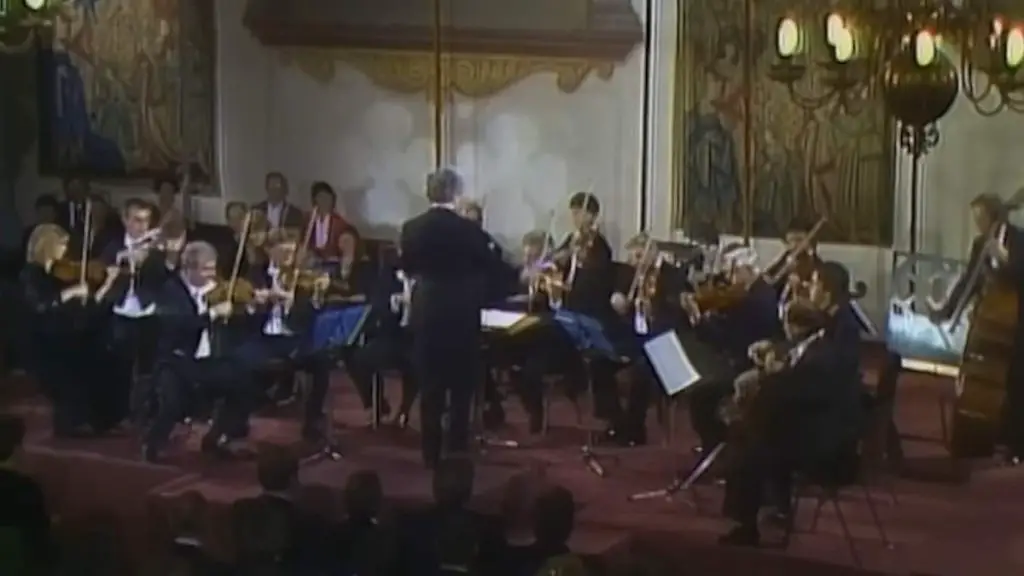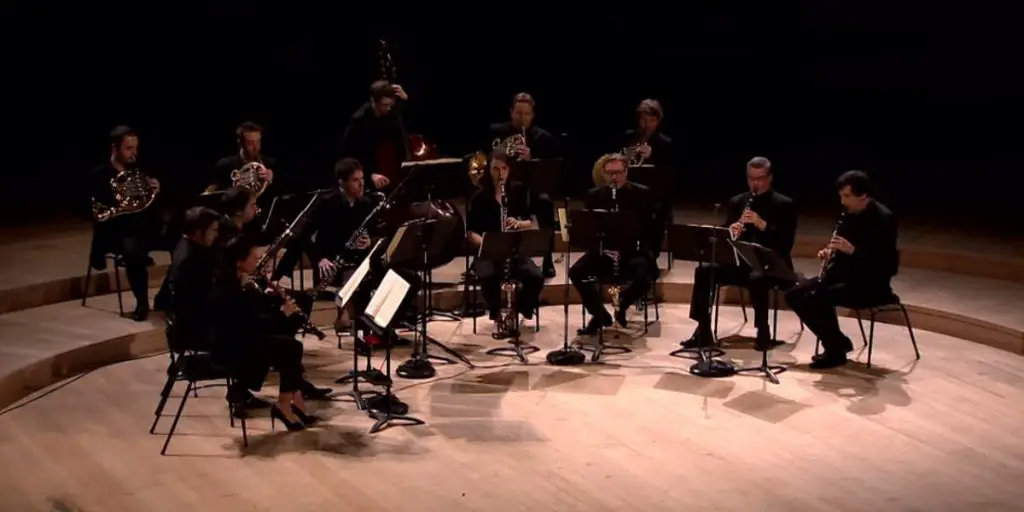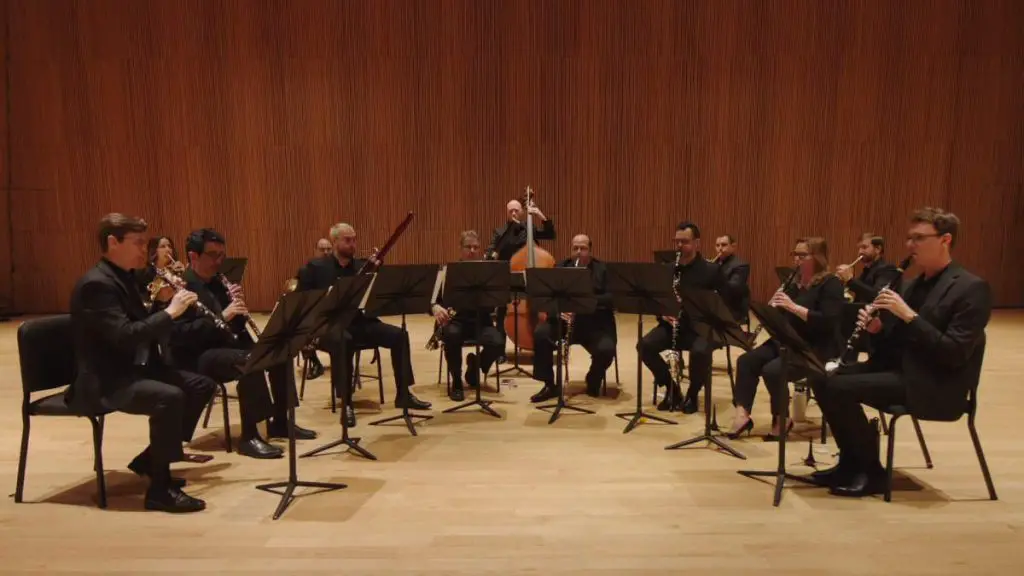Conducted by Sir Colin Davis, members of the Bavarian Radio Symphony Orchestra perform Wolfgang Amadeus Mozart’s Serenade No. 10 “Gran Partita” for winds in B-flat major, K. 361/370a. Recorded at the Historischer Reichssaal in Regensburg, Germany in 1991.
Wolfgang Amadeus Mozart’s Serenade No. 10 “Gran Partita”
Mozart’s Serenade No. 10 in B-flat major, K 361, often referred to as the “Gran Partita,” is one of his most cherished works, especially notable for its instrumentation and mature character. Composed in the early 1780s, this serenade is scored for a wind ensemble consisting of pairs of oboes, clarinets, bassoons, and basset horns, along with four horns and a string bass or contrabassoon. This ensemble configuration was quite unusual for the time, which underscores Mozart’s creative exploration and innovation in instrumentation.
The title “Gran Partita” is a bit of a mystery; it wasn’t Mozart’s own title but appeared on a manuscript copy, and it’s been associated with the work ever since. “Partita” was a term often used interchangeably with “suite” during the Classical period, implying a collection of movements or pieces. The descriptor “Gran” underscores the work’s substantial nature both in terms of length and instrumentation.
The Serenade No. 10 is often admired for its rich textures and the seamless blending of its instrumental voices. Throughout the serenade, Mozart demonstrates a profound understanding of each instrument’s capabilities, crafting lines that exploit their unique tonal qualities while ensuring that they come together to create a cohesive sound.
Beyond its technical achievements, the “Gran Partita” is celebrated for its depth of emotion and expression. Mozart achieves a remarkable balance between the light, entertaining qualities typical of serenades and a more profound, symphonic depth. The work captures a wide emotional spectrum, from buoyant joy to introspective melancholy, showcasing Mozart’s unparalleled ability to convey complex feelings and moods.
Today, the “Gran Partita” remains a testament to Mozart’s genius, celebrated not only for its musical intricacies but also as an embodiment of the Classical era’s ideals of balance, clarity, and expressiveness.
Movements
Mozart’s “Gran Partita” is in seven movements. With the starting times in the video:
Certainly, the “Gran Partita” is a seven-movement serenade. Let’s delve into each movement:
- Largo – Molto allegro [00:12]: This movement starts with a brief, stately introduction (Largo) before transitioning into the lively Molto allegro. This section is characteristic of Mozart’s symphonic first movements, showcasing both his brilliant orchestration and his gift for melody. The structure follows the sonata-allegro form, with contrasting themes and developmental sections that display the composer’s ability to evolve and transform musical ideas.
- Menuetto – Trio I – Trio II [09:32]: Traditional in form, this Minuet and Trio has an elegant, dance-like character. The first Trio introduces a serene, contrasting section, highlighting the mellower tones of the ensemble. The second Trio, meanwhile, features more pronounced rhythms and brighter textures, providing a delightful contrast before the Minuet returns.
- Adagio [18:31]: One of the most profound movements of the serenade, the Adagio is notable for its expressive depth. Mozart uses the winds to create a rich, chorale-like texture. The movement is contemplative and introspective, showcasing the composer’s ability to evoke deep emotion, particularly using a wind ensemble. There’s a sense of yearning and beauty throughout, making it one of the standout sections of the composition.
- Menuetto: Allegretto – Trio I – Trio II [24:07]: This second Minuet is livelier than the first, with a buoyant, rhythmic quality. Both trios present in this movement provide contrasts in terms of tonality and texture. While the movement is still dance-like, Mozart introduces thematic variations that add layers of sophistication to what might otherwise be a straightforward dance form.
- Romanze: Adagio – Allegretto – Adagio [29:48]: The Romanze is a rhapsodic movement, starting and ending with an Adagio section. The central Allegretto section provides contrast, featuring a brighter, more spirited character. The outer sections are serene and almost dream-like, with the winds weaving intricate melodic lines that convey a sense of nostalgia.
- Theme and Variations: Andante [35:36]: As the title suggests, this movement is built on a theme and its subsequent variations. The theme is presented in a straightforward manner, after which Mozart crafts a series of imaginative variations. Each variation showcases different instruments and offers varied tempos and characters, highlighting Mozart’s genius in transforming a simple theme in myriad ways.
- Rondo: Molto allegro [45:24]: The finale of Mozart’s Serenade No. 10 Gran Partita is a rondo, characterized by a recurring, catchy theme that is interspersed with contrasting episodes. The energy is high, bringing the serenade to a jubilant close. Mozart’s skillful interplay between the instruments and his lively rhythms ensures that the work concludes on a spirited and uplifting note.

Sources
- Serenade No. 10 “Gran Partita” (Mozart) on Wikipedia

